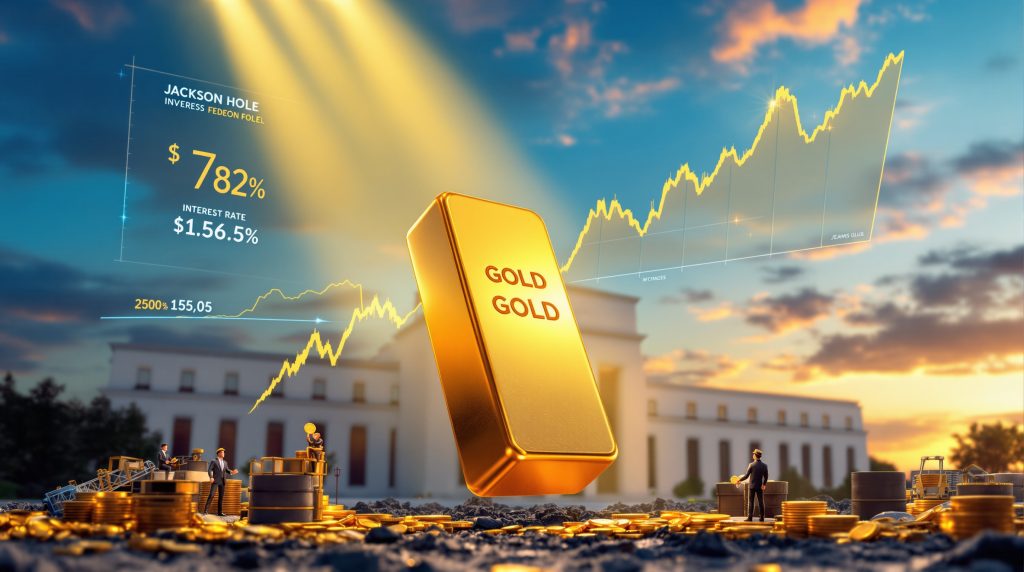Jerome Powell's Jackson Hole Address Stirs Gold Market Reactions
The financial world turned its attention to Wyoming last Friday as Federal Reserve Chair Jerome Powell delivered his highly anticipated Jackson Hole address. Markets had already positioned themselves with high expectations for September rate cuts, but Powell's actual messaging prompted a significant recalibration in sentiment, particularly affecting precious metals markets.
Key Points from Powell's Speech
Powell's carefully worded remarks focused primarily on two critical economic factors: labor market conditions and inflation targets. Prior to his address, markets had priced in over an 80% probability of rate cuts beginning in September, reflecting strong expectations for monetary easing to commence.
The Fed Chair's comments, however, created an immediate reassessment of the likely path forward. Rather than confirming the market's dovish expectations, Powell maintained the Fed's cautious stance, emphasizing the importance of achieving inflation targets before proceeding with rate adjustments.
Traders quickly adjusted positions across multiple asset classes following the speech, with precious metals experiencing particularly pronounced price movements as market participants digested the implications for monetary policy.
Market Expectations vs. Reality
The gap between market expectations and Powell's actual messaging created a notable shift in sentiment. Traders had built up significant positions anticipating a clear signal for September easing, but the speech highlighted the Fed's continued focus on data-driven decision-making rather than committing to a predetermined schedule.
Powell emphasized labor market conditions as a key consideration for future policy decisions, suggesting the Fed remains attentive to signs of economic weakness while balancing inflation concerns. This nuanced approach contrasted with the market's more aggressive rate cut timeline.
The immediate market reaction reflected this realignment of expectations, with traders reassessing the probability of near-term policy adjustments based on Powell's more measured tone regarding the path forward. According to Reuters reports, gold prices initially fluctuated significantly as markets interpreted Powell's cautious language.
How Federal Reserve Policy Impacts Gold Prices
The relationship between Federal Reserve policy and precious metals prices represents one of the most fundamental dynamics in the commodities market, with interest rate decisions having far-reaching implications for gold valuations and mining company operations.
Interest Rate Effects on Precious Metals
Gold and other precious metals typically demonstrate inverse relationships with interest rates due to their non-yielding nature. When rates decrease, the opportunity cost of holding assets that don't generate income diminishes, making gold comparatively more attractive to investors seeking alternatives to lower-yielding bonds or cash instruments.
This relationship explains why gold and silver price momentum closely tracks rate expectations rather than just actual rate changes. Markets price in anticipated policy shifts months in advance, creating price movements well before official announcements.
Mining stocks exhibit even greater sensitivity to anticipated rate changes than physical gold itself. This heightened responsiveness stems from operational leverage, where relatively small gold price movements can significantly impact profitability margins.
Small-cap miners face particularly dramatic valuation swings during monetary policy shifts due to their higher refinancing risks and generally thinner profit margins. When easier monetary conditions appear on the horizon, these undervalued gold stocks often outperform their larger counterparts due to improved financing outlooks.
Mining Industry Cost Implications
The capital-intensive nature of mining operations makes interest rate environments especially consequential for the industry's cost structures. Rate cuts potentially reduce borrowing costs for mining companies, improving project economics and enhancing profit margins.
Operational expenses for gold miners extend well beyond direct extraction costs, encompassing extensive financing requirements for exploration, development, and production activities. Lower rates can significantly improve the feasibility of marginal projects by reducing the hurdle rate for investment returns.
Financing terms for mine development projects typically improve substantially in lower-rate scenarios, enabling companies to access capital at more favorable terms. This can accelerate the development timeline for projects that might otherwise remain economically unviable.
Companies carrying substantial debt loads experience particularly pronounced benefits from monetary easing cycles. Reduced interest expenses flow directly to the bottom line, potentially transforming struggling operations into profitable enterprises without requiring any operational improvements.
Industry-wide cost structures adjust gradually based on prevailing interest rate conditions, with sustained low-rate environments eventually becoming incorporated into longer-term investment decisions and strategic planning throughout the sector.
Latest Gold Price Forecasts Point to Strong Growth
Recent analyst projections suggest substantial upside potential for gold prices, with major financial institutions revising their gold price forecast upward amid changing global economic conditions and persistent central bank buying.
UBS Gold Price Projections
UBS has significantly increased its gold price forecast, now projecting $3,700 per ounce by 2026. This bullish outlook represents a substantial revision from previous estimates and signals growing institutional confidence in gold's long-term fundamentals.
The bank now predicts gold will average $3,600 in Q1 of next year, marking a $100 increase from previous estimates. This upward revision primarily reflects strong demand from ETFs and central banks, with institutional buyers demonstrating sustained appetite despite gold's 28% price increase in 2025.
A particularly noteworthy factor driving UBS's revised outlook is the ongoing shift by central banks away from dollar-denominated reserves. This diversification trend appears resilient even in the face of higher gold prices, suggesting structural rather than cyclical buying patterns.
Central bank purchases continue tracking toward another year of approximately 1,000-ton acquisition volumes. This persistent institutional demand provides a strong foundation for price support even as retail investors demonstrate more variable participation in the market.
Demand Factors Driving Price Expectations
Global gold demand could increase by an additional 3% next year, potentially reaching levels not seen since 2011. This projected growth encompasses multiple demand categories, with institutional buying remaining particularly robust.
Central banks continue to lead the demand picture, actively diversifying reserves away from dollar-denominated assets as part of broader strategic asset allocation shifts. This trend transcends regional boundaries, with buyers emerging from diverse geographic and economic contexts.
ETF investment flows have shown renewed interest in gold exposure after several quarters of outflows. This institutional re-engagement often represents a leading indicator for broader market participation, potentially signaling stronger retail demand to follow.
Demand projections depend heavily on continued central bank purchasing patterns, making policy shifts at major monetary authorities particularly consequential for future price trajectories. Any significant reduction in institutional buying could alter the supply-demand balance considerably.
Macroeconomic risk factors remain critical variables in determining future price movements, with inflation concerns, geopolitical tensions, and currency devaluation fears all contributing to gold's appeal as a portfolio diversifier and store of value during uncertain economic conditions.
Gold Mining Companies Report Strong Performance
Major gold producers are capitalizing on favorable market conditions, with several companies reporting improved operational metrics and strategic developments that position them for continued growth amid all-time high gold prices.
Equinox Gold's Recent Results
Equinox Gold delivered impressive production results, generating over 200,000 ounces of gold in Q2. This output represents a 4% increase from Q1 2025, demonstrating quarter-over-quarter operational improvements across the company's asset portfolio.
All-in sustaining costs were reported at $1,959 per ounce, positioning the company favorably within the industry cost curve given current gold price levels. This cost structure enables substantial margin generation in the current price environment.
The company's financial performance reflected these strong operational results, generating $154 million in mine-site free cash flow during the period. This robust cash generation strengthens Equinox's financial flexibility for future growth initiatives.
Equinox maintains over $400 million in unrestricted cash, providing significant flexibility for potential expansions, debt reduction, or shareholder returns. This strong balance sheet position reduces financing risk even in changing interest rate environments.
The strategic acquisition of Caliber Mining has begun delivering positive financial results, validating the company's growth-through-acquisition strategy. This successful integration demonstrates management's ability to identify and execute value-accretive transactions.
Strategic Industry Developments
Allied Critical Metals recently appointed former US Homeland Security Secretary Kirstjen Nielsen to its American subsidiary board. This high-profile addition signals the company's strategic focus on defense and critical infrastructure markets for tungsten, highlighting the growing intersection between resource security and national security considerations.
In a significant partnership development, Hudbay Minerals secured a $600 million investment from Mitsubishi Corporation for a 30% stake in the Copper World project. This substantial financial commitment from a major industrial conglomerate validates the project's potential and reduces Hudbay's development funding requirements.
The Copper World project represents a major development opportunity, containing over 385 million tons of reserves grading 0.54% copper. These substantial reserves support the project's 20-year anticipated mine life with significant production volumes.
Production targets for Copper World aim to deliver 85,000 tons of annual copper, positioning it as a significant contributor to North American copper supply. The project also promises substantial economic benefits, projecting 1,000 construction jobs and 400 permanent positions upon completion.
This investment highlights growing international interest in securing copper supply chains, with major industrial companies increasingly taking direct ownership stakes in development projects rather than relying solely on market purchases for this critical industrial metal, further supporting positive copper price predictions.
Copper Mining Sector Shows Promising Developments
The copper mining landscape continues to evolve rapidly, with significant exploration successes and ambitious national production strategies emerging in key South American mining jurisdictions.
Marramaka Copper Exploration Results
Marramaka reported impressive drilling results from its PMPA Medina project located in Chile's mineral-rich Atacama region. These latest findings extend high-grade mineralization 300 meters westward from previous discoveries, significantly expanding the project's resource potential.
The sediment-hosted copper system now spans 1.2 kilometers in both directions, demonstrating remarkable continuity and scale. This geological setting typically supports large-tonnage operations with favorable mining characteristics for potential future development.
Standout intercepts include 70 meters averaging 1% copper with a particularly impressive 10-meter section grading 4.2% copper. These high-grade zones enhance the overall project economics by providing potential high-margin material within the broader resource envelope.
Additional zones returned 116 meters of 0.61% copper with multiple high-grade intervals exceeding 1% copper content. This consistent mineralization pattern suggests a well-developed copper system with predictable geometry favorable for mining operations.
These exploration results position Marramaka's project as an emerging copper discovery of potential regional significance, with grade profiles comparable to many producing operations in the area. Further drilling will determine the ultimate scale and economic viability of the resource.
Argentina's Copper Production Ambitions
Glencore has projected that Argentina could produce 1 million tons of copper annually over the next decade, representing a transformative opportunity for the country's mining sector. This ambitious projection would place Argentina among the world's significant copper producers.
The company has submitted applications under Argentina's large investment incentive regime, seeking to advance major projects with improved economic terms. These incentives reflect Argentina's strategic focus on developing its copper resources to diversify economic activity.
Glencore's El Pachon and Agara projects target combined production of 500,000 metric tons, accounting for approximately half of the projected national output. These flagship developments would serve as anchors for a broader copper industry expansion throughout the country.
According to projections shared at a Council of the Americas event, Argentina could potentially supply 2 million tons annually to global markets within 10 years. This would represent a dramatic transformation for a country that has not produced copper since 2018.
This potential copper renaissance represents a significant shift in Argentina's resource development strategy, capitalizing on growing global demand for copper driven by electrification and renewable energy transitions. Success would position Argentina alongside Chile and Peru as a major South American copper producer.
FAQ: Gold Prices and Federal Reserve Policy
How do interest rate decisions affect gold prices?
Gold typically performs well when interest rates decrease because it doesn't offer yield. Lower rates reduce the opportunity cost of holding non-yielding assets like gold, making them more attractive to investors seeking alternatives to low-yielding bonds or cash instruments.
The relationship works in reverse as well – when rates rise or are expected to rise, gold often faces headwinds as yield-bearing investments become comparatively more attractive. This dynamic explains why gold prices frequently react to Federal Reserve communications even before actual rate changes occur.
Most importantly, markets anticipate rate movements months in advance, meaning gold prices often move based on changing expectations rather than the actual implementation of new rates. This forward-looking pricing mechanism makes Fed communications particularly influential for gold markets, as Jackson Hole coverage frequently demonstrates.
Why are central banks buying gold?
Central banks are diversifying their reserves away from dollar-denominated assets to reduce dependency on any single currency. Gold serves as a hedge against currency devaluation, inflation, and geopolitical risks, making it an attractive component of national reserves in uncertain economic environments.
Many emerging market central banks remain significantly underweight gold compared to developed economies, suggesting the potential for continued purchasing as they rebalance reserve portfolios. This structural shift provides persistent demand support independent of short-term price movements.
Central bank purchasing also reflects growing concerns about potential currency debasement through expansionary monetary policies. Gold's historical role as a store of value makes it particularly appealing during periods of unprecedented monetary expansion.
What factors could prevent gold from reaching forecasted price levels?
Several factors could limit gold's price appreciation, including faster-than-expected inflation reduction leading to higher interest rates, strengthening of the US dollar, reduced central bank purchasing, significant mining production increases, or diminished geopolitical risks that reduce safe-haven demand.
A rapid pivot to tighter monetary policy would particularly impact gold sentiment, as higher rates would increase the opportunity cost of holding non-yielding assets. This scenario could emerge if inflation proves more persistent than currently anticipated.
Substantial increases in mine supply could also pressure prices, though the development timeline for new mining projects typically spans years, limiting the risk of sudden supply surges. The industry's production pipeline currently shows limited growth potential in the near term.
How do mining companies benefit from higher gold prices?
Mining companies benefit from higher gold prices through expanded profit margins, increased cash flow, higher valuations, improved access to capital, and greater flexibility to develop new projects or extend existing mine life. Companies with fixed production costs see direct profit increases when gold prices rise.
For producers with all-in sustaining costs around $1,900-2,000 per ounce, each $100 increase in gold prices flows almost entirely to the bottom line. This operational leverage explains why mining stocks often outperform the underlying metal during bull markets.
Higher sustained prices also transform previously uneconomic resources into viable reserves, effectively expanding a company's asset base without additional exploration success. This "reserve growth" can significantly extend mine life projections and support higher company valuations, particularly for junior mining investments.
Further Exploration
Readers interested in deeper analysis of Federal Reserve policy impacts on precious metals can explore educational resources examining historical correlations between monetary conditions and gold performance. These relationships provide important context for understanding potential future price trajectories.
For those focused on mining investments, comparative analysis of company cost structures offers valuable insights into which producers might benefit most from changing gold price environments. Companies with higher operational leverage typically demonstrate greater sensitivity to metal price movements.
Technical analysis of gold price charts relative to key Federal Reserve announcements can reveal patterns useful for anticipating market reactions to future policy shifts. These historical reaction patterns often provide clues about how markets might respond to similar communications going forward.
Ready to Catch the Next Major ASX Mineral Discovery?
Discover why significant mineral finds can generate substantial returns for early investors by exploring Discovery Alert's dedicated discoveries page, where our proprietary Discovery IQ model delivers real-time alerts on noteworthy ASX announcements, turning complex data into actionable investment opportunities.




